Turkish Riviera

The Turkish Riviera (Turkish: Türk Rivierası), also known popularly as the Turquoise Coast, is an area of southwest Turkey encompassing the provinces of Antalya and Muğla, and to a lesser extent Aydın, southern İzmir and western Mersin. The combination of a favorable climate, warm sea, mountainous scenery, fine beaches along more than a thousand kilometers of shoreline along the Aegean and Mediterranean waters, and abundant natural and archaeological points of interest makes this stretch of Turkey's coastline a popular national and international tourist destination.
Among the archaeological points of interest are two of the Seven Wonders of the Ancient World: The ruins of the Mausoleum of Maussollos in Halicarnassus; and the Temple of Artemis in Ephesus.[1]
The Turkish Riviera is also the home of the internationally known Blue Voyage (a.k.a. Carian Cruise), which allows participants to enjoy a week-long trip aboard the iconic local gulet schooners to ancient cities, harbors, tombs, mausolea, and intimate beaches in the numerous small coves, lush forests, and tranquil streams that lace the Turquoise Coast.
The coastline is further regarded as a cultural trove that provides a fascinating mixture of factual and mythological individuals, conflicts and events, and has frequently been referred to in the folklore of various cultures throughout history. As such, it is regarded as the home of scholars, saints, warriors, kings, and heroes, as well as the site of numerous well-known myths. Mark Antony of the Roman Empire is said to have picked the Turkish Riviera as the most beautiful wedding gift for his beloved Cleopatra of Egypt.[2] St. Nicholas, who later became the basis of the Santa Claus legend, was born in Patara, a small town close to present-day Demre.[3] Herodotus, regarded as the "father of History", was born in Bodrum (ancient Halicarnassus) in c. 484 BC.[4] The volcanic mountains to the west of Antalya, near Dalyan, are believed to have been the inspiration for the mythical Chimera — the fire-breathing monster that Bellerophon slew.[2]
Communities and settlements
Many cities, towns and villages in the area are internationally known, such as Alanya, Antalya, Bodrum, Çeşme, Fethiye, Kalkan, Kaş, Kemer, Kuşadası, Marmaris, and Side.
Places on the Turkish Riviera include:
Image gallery

 View of the Dalaman coast
View of the Dalaman coast Moonlight Beach in Kemer
Moonlight Beach in Kemer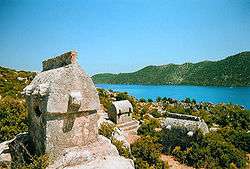 Ancient sites of Kaleköy
Ancient sites of Kaleköy The historic marina of Antalya
The historic marina of Antalya
- Manavgat waterfall
- Alanya city centre and harbour
 Tip of the Alanya peninsula
Tip of the Alanya peninsula

 Katrancı Bay near Fethiye
Katrancı Bay near Fethiye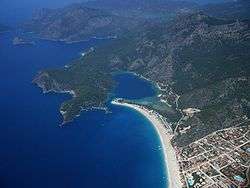 View of Ölüdeniz Beach near Fethiye
View of Ölüdeniz Beach near Fethiye View of Kekova
View of Kekova
 Ancient ruins in Patara
Ancient ruins in Patara.jpg) The ruins of the Temple of Apollo, near Side
The ruins of the Temple of Apollo, near Side- Exterior walls of the ancient theatre in Side
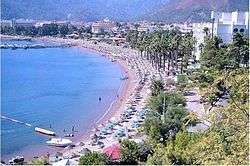 View of İçmeler Beach
View of İçmeler Beach- Roman theatre in Demre, where St. Nicholas lived
 Historic houses of Çeşme
Historic houses of Çeşme Port of Foça, home of the Mediterranean monk seal
Port of Foça, home of the Mediterranean monk seal
 Olympos Beach
Olympos Beach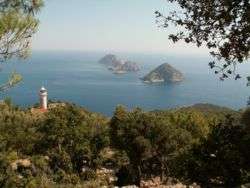 Cape Gelidonya near Finike is the site of the wreck of a Phoenician merchant ship from about 1200 BC
Cape Gelidonya near Finike is the site of the wreck of a Phoenician merchant ship from about 1200 BC Marina of Finike
Marina of Finike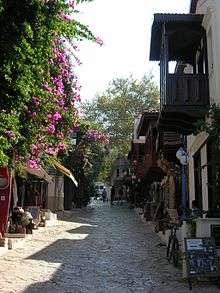 A street in Kaş with traditional houses and a Lycian tomb in the background
A street in Kaş with traditional houses and a Lycian tomb in the background
 Marmaris center
Marmaris center- Harbour of Kalkan
- A view of Kuşadası

See also
- The Blue Voyage
- Marinas in Turkey
- Tourism in Turkey
- Foreign purchases of real estate in Turkey
- Riviera (disambiguation)
Notes
- ↑ "Seven Wonders of Ancient Times". www.sevenwondersworld.com. Retrieved 13 May 2017.
- 1 2 The Mediterranean Region of Turkey ; archived copy at web.archive.org. Archived November 23, 2007, at the Wayback Machine.
- ↑ "St. Nicholas the Wonderworker and Archbishop of Myra in Lycia". oca.org. Retrieved 13 May 2017.
- ↑ "Herodotus". Retrieved 13 May 2017.
Coordinates: 36°40′30″N 31°37′49″E / 36.67500°N 31.63028°E


